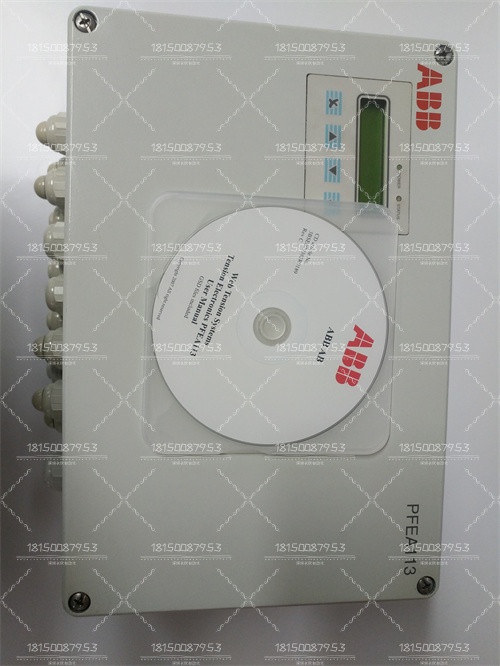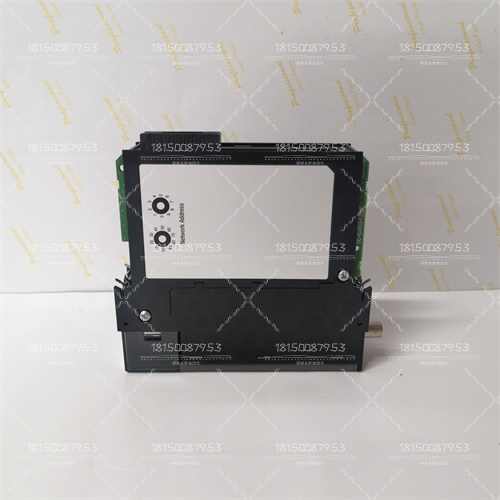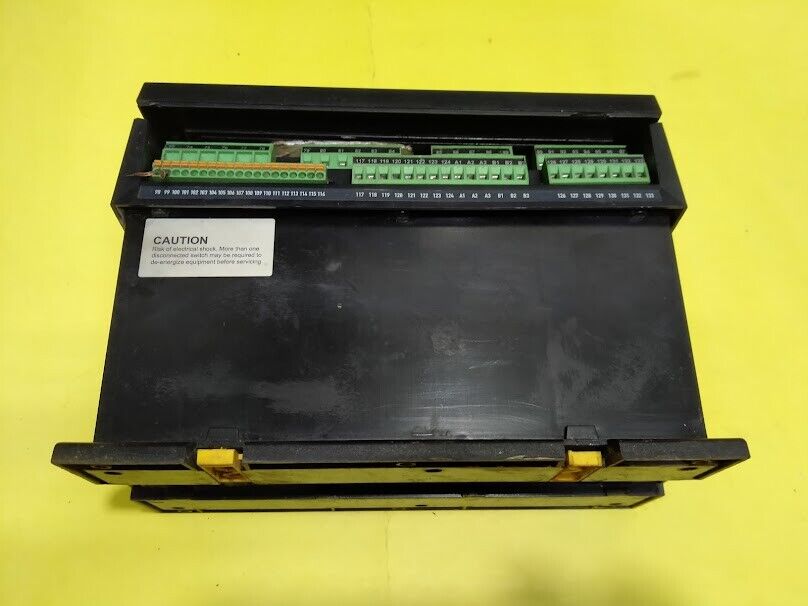描述
ABB的PFEA113-65(3BSE050092R65)是一款高性能张力控制器,属于ABB工业自动化产品线中的Process Performance系列,专为需要精确张力控制的工业场景设计,如金属压延、造纸、纺织、印刷、包装等行业。以下是其核心产品详情:
一、产品概述
型号:PFEA113-65
订货号:3BSE050092R65
类型:数字式张力控制器(Tension Controller)
核心功能:
实时监测并调整材料(如金属带、纸张、薄膜等)的张力,确保生产过程中张力稳定。
支持开环或闭环控制模式,适应不同工艺需求。
集成多种通信接口,可与PLC、HMI或上位机系统无缝集成。
二、核心参数
控制性能
控制方式:PID控制(比例-积分-微分),支持自适应调整。
响应时间:≤10ms(快速响应张力波动)。
控制精度:±0.1%FS(满量程),确保高精度张力控制。
输入/输出接口
模拟输入:
2路(可扩展至4路),支持0/4-20mA或0-10V信号,用于连接张力传感器。
模拟输出:
2路(可扩展),0/4-20mA或0-10V信号,用于驱动执行机构(如磁粉制动器、变频器)。
数字输入/输出:
4路数字输入(DI),用于启动/停止、故障复位等控制。
2路数字输出(DO),用于报警或状态指示。
通信接口:
RS-485:支持Modbus RTU协议,与PLC或HMI通信。
以太网(可选):支持Modbus TCP或OPC UA,实现高速数据传输。
显示与操作
内置显示屏:
3.5英寸彩色LCD,实时显示张力值、设定值、报警状态等。
支持多语言菜单(中文/英文等),便于操作。
按键操作:
4个功能键,用于参数设置、定值修改、手动/自动切换等。
环境适应性
工作温度:0°C至+50°C(工业级设计)。
防护等级:IP20(适合室内安装,需避免粉尘直接侵入)。
抗干扰:符合IEC 61000-4标准,适应强电磁环境(如变频器附近)。
三、功能特点
自适应控制算法
根据材料特性(如弹性、摩擦系数)自动调整PID参数,减少调试时间。
张力补偿功能
支持速度补偿、加减速补偿,确保动态过程中张力稳定。
多段张力控制
可预设多组张力参数,通过外部信号或时间触发切换,适应复杂工艺流程。
故障诊断与保护
实时监测传感器断线、执行机构故障等,并触发报警或安全停机。
支持故障记录存储,便于事后分析。
软件支持
通过ABB的Control Builder或System 800xA软件进行参数配置与逻辑编程。
提供OPC Server功能,实现与第三方系统的数据交互。
四、典型应用场景
金属压延行业
控制冷轧/热轧钢带的张力,防止断带或起皱。
造纸与印刷行业
维持纸张在印刷、复卷过程中的恒定张力,避免套印不准或纸张断裂。
纺织与无纺布生产
控制纱线或无纺布的张力,确保织物均匀性。
包装机械
在薄膜拉伸、封口等工序中,保持包装材料张力稳定。
线缆制造
控制金属线或光纤在绕线过程中的张力,防止变形或断裂。
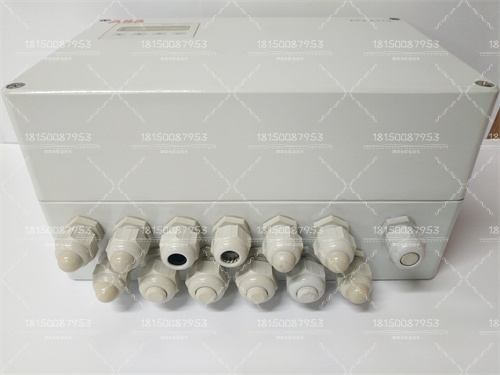
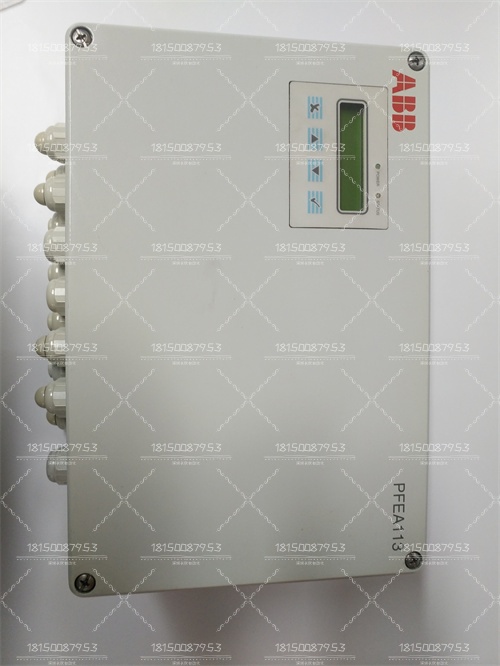
ABB’s PFEA113-65(3BSE050092R65)is a high-performance tension controller.It belongs to the Process Performance series in ABB’s industrial automation product line and is designed for industrial scenarios that require precise tension control,such as metal rolling,papermaking,textiles,printing,packaging and other industries.The following are its core product details:
1.Product Overview
Model:PFEA113-65
Order No.:3BSE050092R65
Type:Digital Tension Controller
Core Function:
Real-time monitoring and adjustment of the tension of materials(such as metal strips,paper,films,etc.)to ensure stable tension during production.
Support open-loop or closed-loop control mode to meet different process requirements.
Integrated with multiple communication interfaces,it can be seamlessly integrated with PLC,HMI or host computer systems.
2.Core Parameters
Control Performance
Control mode:PID control(proportional-integral-differential),support adaptive adjustment.
Response time:≤10ms(quick response to tension fluctuations).
Control accuracy:±0.1%FS(full scale),ensuring high-precision tension control.
Input/output interface
Analog input:
2 channels(expandable to 4 channels),supporting 0/4-20mA or 0-10V signals,used to connect tension sensors.
Analog output:
2 channels(expandable),0/4-20mA or 0-10V signals,used to drive actuators(such as magnetic powder brakes,inverters).
Digital input/output:
4 digital inputs(DI)for start/stop,fault reset and other controls.
2 digital outputs(DO)for alarm or status indication.
Communication interface:
RS-485:Supports Modbus RTU protocol to communicate with PLC or HMI.
Ethernet(optional):Supports Modbus TCP or OPC UA for high-speed data transmission.
Display and operation
Built-in display:
3.5-inch color LCD,real-time display of tension value,set value,alarm status,etc.
Supports multi-language menus(Chinese/English,etc.)for easy operation.
Key operation:
4 function keys for parameter setting,fixed value modification,manual/automatic switching,etc.
Environmental adaptability
Working temperature:0°C to+50°C(industrial-grade design).
Protection level:IP20(suitable for indoor installation,dust should be avoided from direct intrusion).
Anti-interference:Complies with IEC 61000-4 standard,adapts to strong electromagnetic environment(such as near the inverter).
III.Functional characteristics
Adaptive control algorithm
Automatically adjust PID parameters according to material properties(such as elasticity,friction coefficient)to reduce debugging time.
Tension compensation function
Supports speed compensation,acceleration and deceleration compensation to ensure stable tension during dynamic process.
Multi-stage tension control
Multiple sets of tension parameters can be preset,and switching can be triggered by external signals or time to adapt to complex process flows.
Fault diagnosis and protection
Real-time monitoring of sensor disconnection,actuator failure,etc.,and triggering alarm or safe shutdown.
Supports fault record storage for post-analysis.
Software support
Parameter configuration and logic programming are performed through ABB’s Control Builder or System 800xA software.
Provide OPC Server function to realize data interaction with third-party systems.
IV.Typical application scenarios
Metal rolling industry
Control the tension of cold-rolled/hot-rolled steel strips to prevent strip breakage or wrinkling.
Papermaking and printing industry
Maintain constant tension of paper during printing and rewinding to avoid misregistration or paper breakage.
Textile and non-woven fabric production
Control the tension of yarn or non-woven fabric to ensure fabric uniformity.
Packaging machinery
Maintain stable tension of packaging materials during film stretching,sealing and other processes.
Cable manufacturing
Control the tension of metal wires or optical fibers during winding to prevent deformation or breakage.
ABB Model: GBU72 3BHE055094R0002 Model: 3BHE055094R0002 GBU72 Model: GBU72 Model: 3BHE055094R0002 Model: 3BHE031197R0001 Model: 3BHB030310R0001 Model: 73BHE055094R0002 GBU72 Model: 73BHE055094R0002 Model: GBU72 Model: ABB PCS6000 PRODUCT FAMLIY ABB 5SHY4045L0006 3BHB030310R0001 3BHE039203R0101 GVC736CE101

